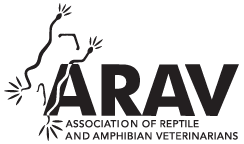Vertebral Osteomyelitis in a Black Spiny-Tailed Iguana (Ctenosaura similis) and a Red Tegu (Salvator rufescens)
This report describes the clinical, gross pathologic, and radiologic features of vertebral osteomyelitis in a black spiny-tailed iguana (Ctenosaura similis) and a red tegu (Salvator rufescens). Both lizards were presented with hind limb ataxia and proprioception deficits. Based on radiographic imaging and computed tomography, a presumptive diagnosis of vertebral osteomyelitis was made. Microbiological examination of vertebral body biopsies revealed Morganella morganii and Enterococcus faecalis infection in the black spiny-tailed iguana and Enterobacter cloacae infection in the red tegu. Failure of antimicrobial treatment in both lizards was considered to be at least partly attributable to the tardy onset of clinical signs resulting in a late diagnosis and pronounced chronicity of the vertebral lesions. Although vertebral osteomyelitis has been repeatedly reported in snakes, reports in saurian species are scarce and anecdotal. Based on the findings in these cases, however, vertebral osteomyelitis should be considered as an important differential diagnosis for hind limb ataxia in lizards.Abstract

Right lateral whole-body radiograph of a black spiny-tailed iguana (Ctenosaura similis). A large opaque concentric structure is seen within the urinary bladder (orange arrow). An ill-defined vertebral delineation is seen at the caudal aspect of third lumbar vertebra (L3) and the cranial aspect of L4 (yellow arrow).

Sagittal (A) and dorsal (B) computed tomography (CT) reconstruction in bone window of the lumbar spine in a black spiny-tailed iguana (Ctenosaura similis): lysis of the vertebral bodies of third lumbar vertebra (L3) and L4 is visible (yellow arrow). R: right. (C) Transverse CT image in soft tissue window: at the caudal aspect of L3, compression of the spinal cord is present (blue arrow). (D) Three-dimensional reconstruction of the skeleton. The lesion at L3 and L4 is indicated by the yellow arrow.

Sagittal (A) and dorsal (B) computed tomography (CT) reconstruction in bone window of the lumbar spine in a red tegu (Salvator rufescens). In both images, severe geographic to permeative osteolytic changes at the endplates of second lumbar vertebra (L2), L3, and L4 (yellow arrow) and L8 (orange arrow) can be seen as well as ventral new bone formation. (C) Transverse CT image in bone tissue window: at the caudal aspect of L8 osteolytic changes and extensive new bone formation can be observed (orange arrow). (D) Three-dimensional reconstruction of the skeleton. The lesions at the level of L2, L3, and L4 and L8 are indicated by the yellow and orange arrow, respectively.



